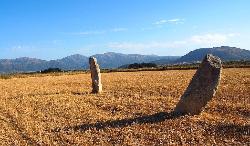Skip navigation bar and go to contents
Vivere la campagna
 Agricoltura
Agricoltura
 Ambiente
Ambiente
 Bilancio e Patrimonio
Bilancio e Patrimonio
 Consigliera di Parità
Consigliera di Parità
 Cultura
Cultura
 Formazione Professionale
Formazione Professionale
 Immigrazione/Emigrazione
Immigrazione/Emigrazione
 Innovazione Tecnologica
Innovazione Tecnologica
 Lavori pubblici e Viabilità
Lavori pubblici e Viabilità
 Lavoro
Lavoro
 Personale
Personale
 Pianificazione Territoriale
Pianificazione Territoriale
 Politiche giovanili
Politiche giovanili
 Politiche Sociali
Politiche Sociali
 Protezione civile
Protezione civile
 Pubblica Istruzione
Pubblica Istruzione
 Sport
Sport
 SUAP
SUAP
 Trasporti
Trasporti
 Turismo
Turismo
 URP
URP

Thanks to its fertility and its geographical position, the lands of the province of Middle Campidano were settled and frequented since most ancient ages. A number of sites and finds have confirmed the presence and permanent dwellings of peoples and nations, alternating throughout the centuries. Among the best-known places are significant Nuragic sites such as the complex of Barumini, recognized as a World Heritage Site by UNESCO. Subsequent ages have left Phoenician/Punic sites (city of Neapolis) and Roman settlements (Thermae of Sardara).Certainly, the imposing evidence dating back to the Middle Ages is noteworthy, too, as it has validated the strategic importance of this central area: this is the case of the castles of Monreale, Las Plassas and Sanluri, (the only instance of edifice dating back to Sardinian local kingdoms to be still inhabitable).
 Siddi, ‘Sa Domu ‘e s’Orcu’
Siddi, ‘Sa Domu ‘e s’Orcu’ Thermae of Sardara
Thermae of Sardara Ussaramanna, Nuraghe San Pietro
Ussaramanna, Nuraghe San Pietro Villanovaforru, Archaeological Civic Museum
Villanovaforru, Archaeological Civic Museum Villanovaforru, archaeological park ‘Genna Maria’
Villanovaforru, archaeological park ‘Genna Maria’ Villanovaforru, archaeological restoration laboratory
Villanovaforru, archaeological restoration laboratory Villanovafranca, Archaeological Civic Museum ‘Su Mulinu’
Villanovafranca, Archaeological Civic Museum ‘Su Mulinu’ Villanovafranca, Nuragic fortress ‘Su Mulinu’
Villanovafranca, Nuragic fortress ‘Su Mulinu’